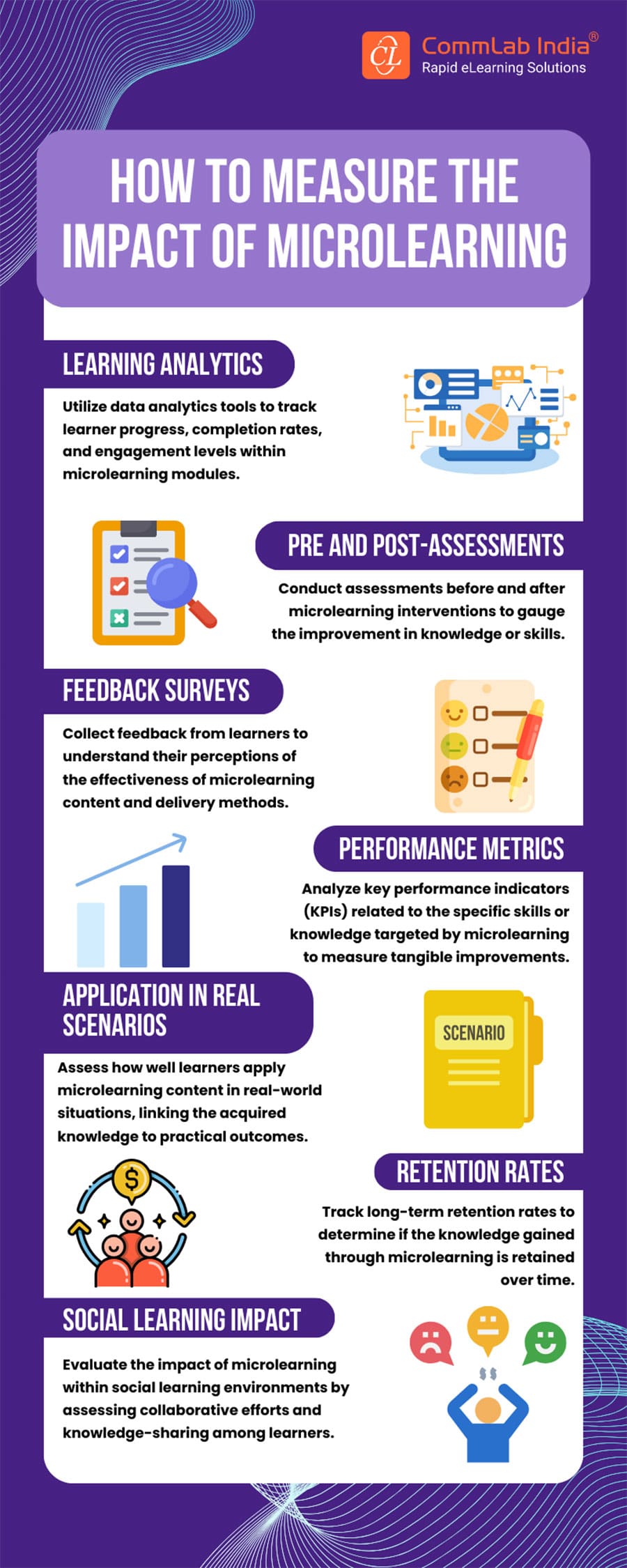Microlearning Done Right: Design Assets That Engage and Perform!

You must have seen various informative content in the form of short videos, infographics, presentations, or even games. This approach of providing new information and related knowledge to employees in little chunks is called microlearning.
According to Ebbinghaus’s Forgetting Curve, people tend to lose around 80% of the information they gain or knowledge they learn within a month. The idea of microlearning is a viable counter to this cause as it helps the employees at a job to learn new information in a short period without a negative impact on their busy schedule.
Microlearning is a perfect approach to meet the requirements of the new-age employees. It eliminates the problematic and lengthy traditional practices like reading through monotonous PDFs and irrelevant yet long videos. This learner-centric approach helps the employees retain the information they gain for a longer period, hence beating the forgetting curve.
→ Download Now: Microlearning — Where Does It Fit in Your Learning Strategy?
Table Of Content
- What are the Key Elements of Effective Microlearning?
- How to Master Designing Quality Microlearning Assets?
- How to Measure the Impact of Microlearning?
What are the Key Elements of Effective Microlearning?
Curious about how to create microlearning experiences that work wonders? Check out our infographic for the key elements you need to know!
How to Master Designing Quality Microlearning Assets?
1. Identify the Areas Where Microlearning Fits the Best
Microlearning solutions have several benefits that would make it look like every training strategy can fit microlearning within them, which is wrong. Not every corporate training program would support the microlearning approach with the same return of value because various topics can be too complex to break down into short sub-topics.
The frequency, importance, difficulty of learning, and the risk factors related to the task determine whether it can be taught through microlearning. For instance, if the frequency of performing a task is low and not very risky, microlearning can provide just-in-time support.
To ensure microlearning fits in your training, try to divide the training material into short modules of 2-4 mins and see if it works or not. This practice can give you a brief idea of whether your training program supports the approach of microlearning or not. A few examples of topics where microlearning fits best are business management ideas, instructions to use a tool or learning about new software, cyber-security awareness, etc.
2. Select a Suitable eLearning Authoring Tool
Selecting a suitable eLearning authoring tool is a critical step in mastering microlearning design. The right tool enables you to create engaging, bite-sized content that aligns with the principles of microlearning—short, focused, and easily digestible. Look for an authoring tool that offers user-friendly features, such as templates for microlearning modules, interactive elements like quizzes or gamification, and compatibility with mobile devices. By choosing the right platform, you can ensure your microlearning design is both impactful and efficient, meeting the needs of modern learners.
Here are 5 top eLearning authoring tools you need to check out for incredible microlearning design!
3. Repurpose Content
A full eLearning course has a lot of distinct content, but all the content collectively comes under a certain subject. That single course can be split into several sub-topics and provided to employees separately. For example, a leadership training program can be broken into microlearning modules covering topics like effective communication, conflict resolution, decision-making, team management, and emotional intelligence. Reworking courses in this way saves time and effort, ensuring you don’t need to create new content each time a new group of employees requires training.

Watch our emotional intelligence sample course in action!
4.Incorporate Rich Multimedia
Incorporating various multimedia adds depth and engagement to microlearning modules. Visuals enhance comprehension, and interactive features keep learners actively involved, transforming brief learning moments into impactful experiences. Visual learners benefit from graphics and animations, while auditory learners engage with audio content. The blend of rich multimedia elements not only captures learners' attention but also transforms microlearning into a multi-sensory experience, offering a better understanding of the subject matter.
5. Apply Interactive Elements Across Multiple Formats
No one likes to read long texts and watch irrelevant monotonous videos for hours and that’s where the variety of microlearning formats does the magic . When you include multiple formats and relevant information to create your microlearning program, eventually increases learner engagement. When you mix and match these different formats to create the final microlearning module, learning becomes more fun and exciting.
Discover the bite-sized learning formats that pack a big punch!
6.Use Microlearning Videos
Videos are inarguably the most popular learning format and go a long way in imparting skills in an effective, engaging manner. You can use microlearning videos to build technical skills. These learning media elements can be used to demonstrate the functioning of various components of products in a highly effective manner. For instance, a video can be used to explain how the picture tube of a television works very clearly. You can also use bite-sized videos to provide good just-in-time support to service technicians. Check out this scenario.
A service technician is called to repair a faulty air conditioner. The technician checks the device and determines that the problem lies with its compressor and should be replaced. He accesses a 6 minute video, on his iPad, which demonstrates the steps of the procedure to replace the compressor and fixes the problem.
Microlearning videos can also be used to develop communication skills. Learners can be shown how to get the various aspects of communication such as body language, tone, gestures, and so on right so that they can convey the intended message effectively.
7. Incorporate Gamification
We all know that stress is the biggest enemy of effective learning. Gamified microlearning can be used to very effectively to impart skills of higher order such as leadership abilities, in a fun-filled manner. One of our clients in the manufacturing space has developed short web-based, gamified business simulations to complement the learning delivered in classroom sessions. These simulations proved to be very effective in helping learners hone their negotiation and decision-making skills.
8. Offer Personalization
By recognizing and accommodating diverse learner preferences, organizations can create more engaging and effective microlearning modules. One key aspect of personalization in microlearning is content customization. Offering learners, the ability to choose topics or learning paths based on their interests or skill gaps empowers them, making the learning experience more relevant and enjoyable.
Furthermore, incorporating personalized feedback mechanisms enhances the learning journey. Offering learners specific insights into their strengths and areas for improvement not only motivates them but also facilitates a targeted approach to skill development. Technology plays a crucial role in personalization. Leveraging data analytics and AI tools, organizations can analyze learner behaviors and preferences to deliver tailored content recommendations.
Learn 4 winning practices to make personalized learning a success!
9. Ensure Mobile-First Design
Learners have switched their prime learning medium from desktop to mobile. Modern learners spend most of their free time with their smartphones, thus having access to their mobile learning resources on the go will improve the engagement and comfort of learners. Learners can engage with short modules during brief breaks, commutes, or other spare moments, fostering a continuous learning experience. Mobile phones are much more than distracting pieces of modern technology, isn’t it? The microlearning tools can help you in creating mobile-friendly exclusive courses that can be shared among the employees and accessed everywhere while the courses are fun and exciting as well.

Where Does Microlearning Fit in Your Learning Strategy?
Uncover the Secrets to Crafting High-performing Micro Assets!
- What Microlearning is and What it is NOT?
- Types of Microlearning Assets
- Tips and Tools for Rapid Microlearning Development
- And More!
How to Measure the Impact of Microlearning?
After designing effective microlearning assets it’s essential to measure their impact to truly understand their value. This infographic outlines key strategies to evaluate how microlearning benefits your learners and drives results.
Wrapping up!
The successful design, implementation and evaluation of microlearning hinges on thoughtful strategies that engage learners and deliver measurable outcomes. By incorporating interactive elements, personalization, mobile-friendly designs, and progress tracking, organizations can create a dynamic microlearning ecosystem.
Want to take your microlearning assets to the next level? Download our eBook and discover how to create impactful resources that drive tangible results and boost macro performance.






![What are the Steps for Effective Microlearning Design? [Infographic]](https://blog.commlabindia.com/hubfs/blogs/steps-effective-microlearning-design-info.jpg)

